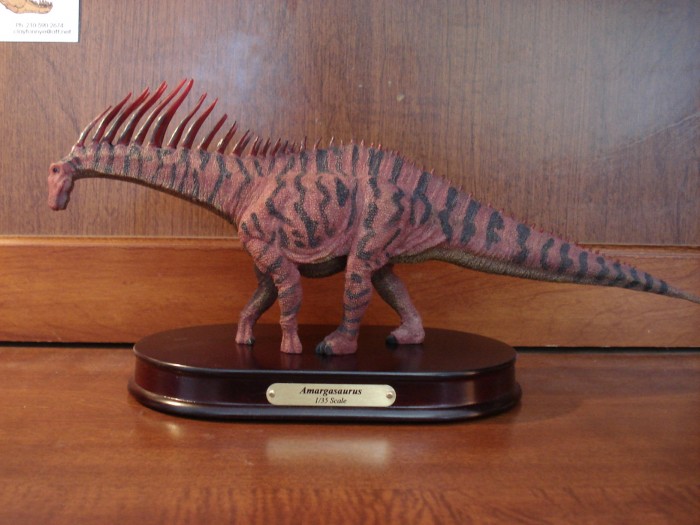Review: Tenontosaurus (Antediluvia Collection)(David Krentz)

4.3 (6 votes)
The grand history of paleontology puts quite a bit of emphasis on Iguanodon. As a child, I could never understand why people failed to recognize this dinosaur, especially when all the books lavished it with so much attention. It was almost as though they weren’t reading the books at all.
Review: Therizinosaurus (Great Dinosaurs Collection by Safari Ltd)
Review: Einiosaurus “Buffalo Bill” (David Krentz)

4.4 (7 votes)
Despite the constant presence of prehistoric collectibles in my shop, it may surprise people to know that I’m not much of a collector. I don’t feel compelled to own most things I see, even the truly awesome things. If space and money were never an issue, I would still exercise restraint.
Review: Apatosaurus (Antediluvia Collection)(David Krentz)

4.8 (9 votes)
Apatosaurus has come a long way over the years. What was once a sluggish swamp-dwelling behemoth is now more tightly built, with muscular columns of legs supporting a powerful body, graceful neck, and elegant whip-like tail. As the rest of the world struggles to keep pace with the latest paleontological research, David Krentz is always perched on the cutting edge.
Review: Leaellynasaura (Walking with Dinosaurs by Toyway)
Review: T. rex Hatchling (Dino Discoveries by Safari)

2.9 (10 votes)
Review by Patrick Krol
Since I started collecting dinosaur figures I wanted to have dinosaur eggs in my collection, but couldn’t find a good one anywhere. Then, when I discovered about the foreign museum lines through internet, I found out that Safari had done some hatchling dinosaurs and they were soon in my “things to buy” list.
Since I started collecting dinosaur figures I wanted to have dinosaur eggs in my collection, but couldn’t find a good one anywhere. Then, when I discovered about the foreign museum lines through internet, I found out that Safari had done some hatchling dinosaurs and they were soon in my “things to buy” list.
Review: Hyaenodon (AAA)

3.5 (8 votes)
Review and photos by Mihnea (Wildheart)
Existing for approximately 26 million years, Hyaenodonts were some of the largest predators of the Late Eocene and Early Miocene epochs. Their name comes from the sharp hyena-like teeth used to tear apart possible prey. The skulls of these animals were huge and well equipped for hunting, but their brains were quite small, something typical in primitive carnivorous mammals.
Existing for approximately 26 million years, Hyaenodonts were some of the largest predators of the Late Eocene and Early Miocene epochs. Their name comes from the sharp hyena-like teeth used to tear apart possible prey. The skulls of these animals were huge and well equipped for hunting, but their brains were quite small, something typical in primitive carnivorous mammals.
Review: Amargasaurus (Desktop model by Favorite Co. Ltd.)

3.4 (8 votes)
Most sauropods tend to more or less look similar; big body, long neck long tail. Rarely will a sauropod possess any distinguishing characteristics beyond those three things. Then there is Amargasaurus. This dinosaur was a smaller (relatively speaking) sauropod from the early Cretaceous in what is now Argentina.
Review: Woolly rhinoceros (AAA)
Review: Rhoetosaurus (CollectA)

3.4 (8 votes)
Review by Nathan, edited by Plesiosauria.
Rhoetosaurus brownei was an Australian sauropod that lived around the mid-Jurassic Period and is one of the oldest known sauropods. Little evidence has been found for this dinosaur, only a partial hind leg, some vertebrae, ribs, and pelvic elements are known, yet CollectA decided to release one as part of their standard collection back in 2009.
Rhoetosaurus brownei was an Australian sauropod that lived around the mid-Jurassic Period and is one of the oldest known sauropods. Little evidence has been found for this dinosaur, only a partial hind leg, some vertebrae, ribs, and pelvic elements are known, yet CollectA decided to release one as part of their standard collection back in 2009.
Review: Entelodont (AAA)

4 (9 votes)
Admittedly, there were lovelier animals to have walked the earth in prehistoric times than entelodonts, omnivorous beasts that were two metres tall and four metres long. Entelodonts were especially abundant in what are now Mongolia, China and Northern America and strolled through the landscape searching for any kind of food in the Eocene epoch – mainly probably carrion.







